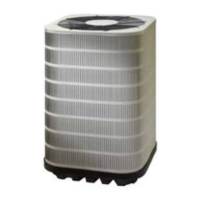9
HEAT PUMP MAINTENANCE
WARNING:
To prevent electrical shock, personal injury, or
death, disconnect all electrical power to the unit
before performing any maintenance or service.
The unit may have more than one electrical
supply.
Proper maintenance is important to achieve optimum
performance from the heat pump. The ability to properly
perform maintenance on this equipment requires certain
mechanical skills and tools. If you do not possess these
skills, contact your dealer for maintenance. Consult your
local dealer about the availability of maintenance contracts.
Routine maintenance should include the following:
• Inspectandcleanorreplaceairltersatthebeginning
of each heating and cooling season, or more frequently
if required.
• Inspecttheoutdoorcoilatthebeginningofeachcooling
season. Remove any debris. Clean the outdoor coil
and louvers as necessary using a mild detergent and
water. Rinse thoroughly with water.
• Inspecttheelectricalconnectionsfortightnessatthe
beginning of each heating and cooling season. Service
as necessary.
valve. A common suction port for heating mode charging
is included and located on the compressor access panel
above the outdoor unit service valves.
• HeatModeVericationTables(Tables3-9,pages15
- 17) are provided for quick reference when the unit
is in heating mode and for the inspection of the liquid
line pressures and temperatures.
Charging the Unit in AC Mode with Outdoor
Temperatures Above 55° F
(for optimized sub-cooling of 10° F to 12° F)
1. With the system operating at steady-state, measure
the liquid refrigerant pressure (in PSIG) at the outdoor
unit service valve.
2. Measure the liquid refrigerant temperature (in
Fahrenheit) at the service valve.
3. Determine the required liquid refrigerant pressure from
Figures 4-10 (pages 10-13) .
• IfthepressuremeasuredinStep1isgreaterthan
the required liquid refrigerant pressure determined in
Step 3, then there is too much charge in the system.
Remove refrigerant and repeat Steps 1 through 3
until the system is correctly charged.
• IfthepressuremeasuredinStep1islessthanthe
required liquid refrigerant pressure determined in
Step 3, there is too little charge in the system. Add
refrigerant and repeat Steps 1 through 3 until the
system is correctly charged.
CAUTION:
The unit should never be operated without a
filter in the return air system. Replace disposable
filters with the same type and size.
• Donotaddadditionaloiltomotorsunequippedwith
oil tubes. The compressor is hermetically sealed at the
factory and does not require lubrication.
COMPONENT FUNCTIONS
Comfort Alert
TM
Diagnostics - The Comfort Alert
diagnostics module troubleshoots heat pump and air
conditioning system failures and accurately detects the
cause of electrical and system related failures without
any sensors. A flashing LED indicator communicates the
ALERT code to quickly direct the technician to the root
cause of a problem.
High Pressure Switch (HPS) - A high-pressure switch is
factory-installed and located in the compressor discharge
line internal to the outdoor unit. The switch is designed to
de-energizethesystemwhenveryhighpressuresoccur
during abnormal conditions. Under normal conditions, the
switch is closed. If the discharge pressure rises above
575psig,thentheswitchwillopenandde-energizethe
outdoor unit. The switch will close again once the liquid
pressure decreases to 460 psig. Please note that the
switch interrupts the thermostat inputs to the unit. When
the switch opens and then closes, there will be a 5 minute
shortcyclingdelaybeforetheoutdoorunitwillenergize.
Low Pressure Switch (LPS) - A low-pressure switch is
factory-installed in select models only. If provided, this
located in the suction line internal to the outdoor unit. The
switch is designed to protect the compressor from a loss
of charge. Under normal conditions, the switch is closed.
If the suction pressure falls below 5 psig, then the switch
willopenandde-energizetheoutdoorunit.Theswitch
will close again once the suction pressure increases
above 20 psig. Please note that the switch interrupts the
thermostat inputs to the unit. When the switch opens and
then closes, there will be a 5 minute short cycling delay
beforetheoutdoorunitwillenergize.

